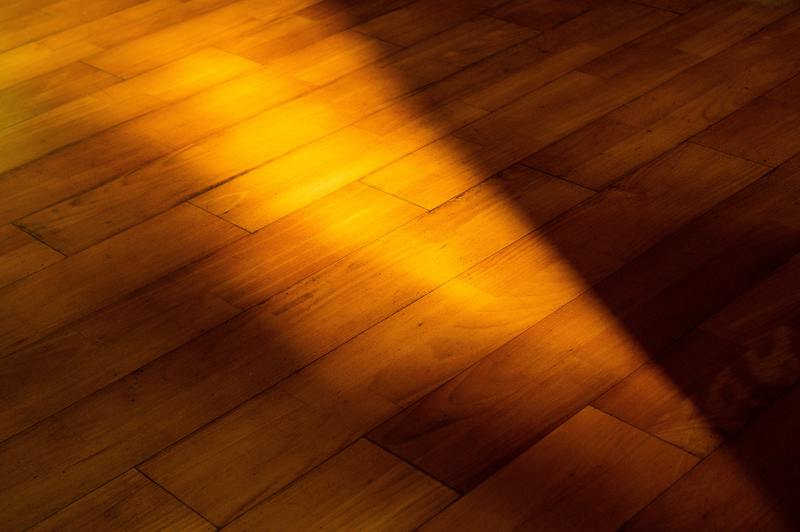On hardwood, rings, marks, and stains are regular. Don’t be alarmed! This guide on how to bleach water damaged hardwood floor will address your most often asked questions about bleaching, cleaning, and maintaining hardwood floors.
Water stains on hardwood floors and furniture can make you assume they’re hopelessly damaged. However, there are a few ways to restore the appearance of your hardwood floors.

Hang in there! We’ll be going on with the easiest ways to bleach your water-damaged floors.
Bleaching Water-Damaged Wood Floors
When spills occur on wood floors, a fast wipe (and sometimes some cleaning solution) is generally all that is required to clear up the mess. However, if spills and other mishaps are ignored, they can turn into permanent wood floor stains.
Perhaps a family member left a full glass on the floor overnight, or someone did not thoroughly clean up a spill. Bleach will always be a necessary cleaning agent in our home. Here are simple guides in using them properly on hardwood floors, depending on how severe the water damage is.
Method #1. Using commercial bleach
Step #1. The wood piece’s finish should be sanded off.
Note: For the next several steps, make sure you’re wearing gloves.
Step #2. Rub essential household bleach into the stain with an old toothbrush or a paintbrush.
Step #3. Allow two hours for the bleach to evaporate.
Step #4. In the same way, apply more bleach and allow it to sit overnight.
Water stains from deep into the wood are removed with this method. You can refinish the wood once the colors have been removed. If the stain remains, you may need to resort to using wood bleach.
Method #2. Using bleach solution
Dark water stains on the wood are tough to remove. However, you may remove stubborn stains by gently bleaching the wood using a weak household bleach solution. Because bleach is corrosive, you should use waterproof gloves for this approach.
Step #1. Mix 50 percent chilly water and 50 percent bleach in a mixing bowl.
Step #2. Using a dense sponge, lightly apply the solution to the wood stains. Do not soak the wood in water.
Step #3. Allow for complete drying of the bleached wood. Depending on the weather, this could take a day or two.
Step #4. Examine the outcomes. If a more robust solution is required, adjust the proportions to 25% water and 75% bleach and reapply.
Method #3. Using wood bleach
You may need to use wood bleach to remove stubborn black water stains.
Step #1. After removing the wood finish on the hardfloor, use a brush to apply mixed wood bleach to the wood.
Step #2. Allow 3-4 hours for the wood bleach to work.
Step #3. Apply a sponge to two parts of water and one part vinegar to neutralize the wood bleach.
Step #4. Once the stain is gone, dry the wood and refinish it.
Removing Stubborn Dark Water Stains From Wood Floors
Any table with a peeling surface is likely veneer. Solid wood is impervious to peeling.
It splits or cracks. If the surface coating has been weakened or worn off, direct water exposure or condensed moisture can start a veneered wood on any table to peel or deform.
Step #1. Sand the area
Sand the table’s surface using a hand block and 100-grit sandpaper by hand. Only sand parallel to the grain. Sand any loose threads that have coiled up or split from the table’s surface.
Step #2. Lighten the spot
To remove any debris, chips, or loose fibers that may have found their way under the veneer, use an air compressor with an air nozzle to spray air over the table. If some of them are stubborn and won’t come out, carefully scrape them out using the tip of a putty knife.
Step #3. Apply new finish
Follow the manufacturer’s directions for mixing the powdered resin glue with water. Dip the putty knife’s tip into the glue. Allow the glue to scrape off the underside of any loose veneer pieces with the wet putty knife.
Are there alternatives for bleach?
If you address a surface stain quickly with one of the beach alternatives listed in this article, you may be able to remove it. If you’re dealing with darker stains, though, you’ll need to be more specific.
Without using bleach, here are some tried-and-true solutions for eliminating typical stains from your hardwood floors.
- Oil and grease – Scrub the oil and grease stains in a circular motion using dish soap and water mixture.
- Pet stain – Scrub the area with a towel dampened in a solution of four parts water and one part white vinegar. Sprinkle baking soda on the odor to absorb it, then wait 10 minutes before wiping it away with a moist towel.
- Water stains – Cover the stain with a cloth and press it with a hot clothes iron for several minutes.
Conclusion
Stains on wood floors can be ugly and distracting for a variety of reasons. Before you get too worked up about a blemish on your wood floor, keep in mind that you might be able to remove the stain from your lovely hardwood floors.
You might be able to cure the stain depending on the type and depth of the stain. We hope, fingers crossed, that we have answered all of your questions about “how to bleach water damaged hardwood floor.”“
